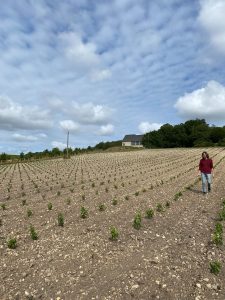Our First Visit to the Clos des Brancs Monopole Vineyard (Hauts-Baigneux)
When Philippe Mesnier of Domaine des Hauts-Baigneux invited the team to stay over for a night, we jumped on the opportunity.
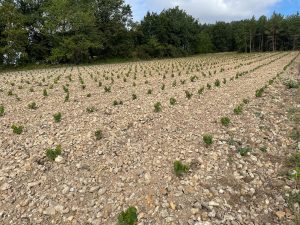
We were greeted with a lovely apéro on arrival before settling into our rooms, then We spent a delightful evening tasting (repeatedly) through the wines of the domaine. We discussed anything and everything that came to mind—mostly wine—and enjoyed a feast of the most exquisite fruit, vegetables, and meats, all of which were cultivated by the estate.
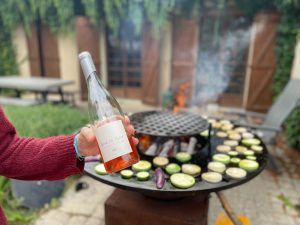
The following morning, we were treated to a visit to the impressive Clos des Brancs, a monopole hamlet for the estate. As we looked up, Philippe described how wild land used to be, as it is connected to the adjacent ˛ woods, enclosing the subsided vines on the hill; today, it’s an open horizon of its own. Pointing to one side, he showed us an old clonal selection of Chenin, which dates back to the 1950s. Harvests of colder years, such as that of 2021, will become Chenin Spontané, while those of warmer years will contribute their persistent freshness and acidity to the flagship Blanc Chenin, the wine that embodies Domaine des Hauts-Baigneux’s broadest expression of Azay-le-rideau’s terroir.
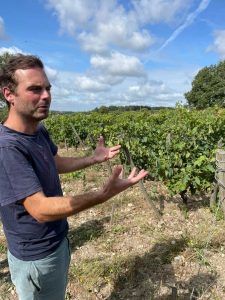
Looking at these vines, we already see bunches. Philippe describes them as “blockwork.” Closely grouped together, they struggle on most other parcels, but on this hill, these clusters do not gather moisture or invite rot, thanks to the wind, and the soil allows them to produce concentrated fruit with the required freshness and acidity that make for expressive and interesting wines.
Walking a little further, we reach “the young vines.” This 40-year old massal selection is the beating heart of Clos des Brancs. It’s from those that the eponymous cuvée will be produced. Here, the clusters have visibly more space, and reliably deliver intense and commanding grapes. Describing this particular expression of the land, Philippe compares it to a charging force, and his work is to rein it in and help it express its more delicate nuances.
The hill is on the northern side of the valley cut by the Indre river. Water from the Indre nourishes all of the Azay-le-Rideau appellation. With the parcel facing due south, the northern climate can express itself powerfully and regularly gives high maturities. The soil reinforces this distinctive balance: a carpet of flint with an orange hue reflects the sunlight and heat back to the vines, but digging a couple of centimeters reveals a surprisingly cold soil that keeps the roots cool. This is where the freshness in the wines comes from.
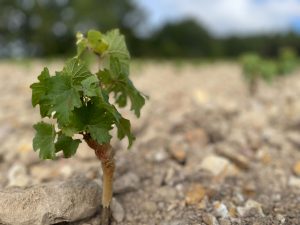
The Clos des Brancs is turning a new page in its history. In June 2022, Domaine des Hauts-Baigneux began planting new rows of Chenin, as well as some Grolleau. To do so, they traveled across the Loire valley looking at vines, and crafted their own massal selection issued from vines in Anjou, Saumur, and Vouvray. The young Chenin are projected to go to the Spontané Chenin, especially in cooler years. In more concentrated harvests, it might go to Blanc Chenin. Philippe reminds us that nothing is set in stone, and that tasting in the cellar will determine everything. As they have always done, they will vinify not only by parcel, but by selection within the same parcels. This gives the wines room to express themselves as fully as they can, and allows for blends to adapt and play to the strengths of each harvest.
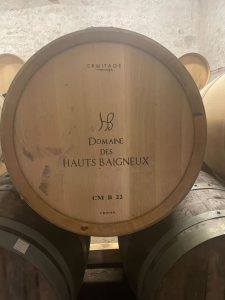
This turn of the page is also a return of history. Overlooking the parcel stands Alexander Calder’s former workshop, now an artist residency. Calder’s work and life there is immensely influential to the region, through his very active participation in the community. Growing up, Philippe remembers a Calder mobile, donated by the artist, permanently on display at his school. Calder’s works were a catalyst to his appreciation of modern and contemporary art, and remain to this day a reference point to him. It’s impossible, then, to describe the excitement he felt when the Calder Foundation leased to Hauts-Baigneux the land they have on the hamlet for farming; to Philippe’s surprise, the excitement was mutual. Alexander Rower, grandson of the artist and president of the Calder Foundation, recalled childhood summers at the workshop looking at the vineyard below. To both of them, there was no question of these vines being grown in any other way than with organic and biodynamic practices.
Clos des Brancs is a very special hamlet with a rich history and a stunning land. Domaine des Hauts-Baigneux pays tribute to both, and their future projects on this soil are full of a promise that we can hardly expect anywhere else.




